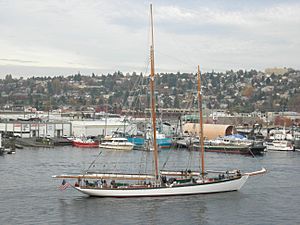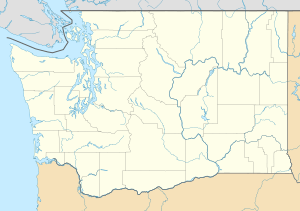Zodiac (schooner) facts for kids

Zodiac motoring east along the Lake Washington Ship Canal, just east of the Ballard Bridge, Seattle, Washington
|
|
| History | |
|---|---|
| Name |
|
| Owner |
|
| Builder | Hodgdon Brothers |
| Launched | 1924 |
| Identification |
|
| Status | Historic landmark |
| General characteristics | |
| Tonnage | 145 tons (gross) 89 (net) |
| Displacement | 220 tons |
| Length | 160 ft (49 m) (LOA) 127 ft (39 m) (on deck) |
| Beam | 25.2 ft (7.7 m) |
| Draft | 15 ft (4.6 m) |
| Depth of hold | 11.5 ft (3.5 m) |
| Propulsion | Caterpillar 400 hp (300 kW) diesel |
| Sail plan | Gaff-rigged topsail schooner 7,000 sq ft (650 m2) |
| Speed | 13.4 knots (24.8 km/h; 15.4 mph) (max), 9 knots (17 km/h; 10 mph) (powered) |
|
Zodiac (schooner)
|
|
| Location | Bellingham, WA |
| Built | 1924 |
| Architect | William Hand, Jr. |
| NRHP reference No. | 82004248 |
| Added to NRHP | 29 April 1982 |
The Zodiac is a beautiful two-masted schooner, which is a type of sailing ship. It was designed by William H. Hand, Jr. for the Johnson brothers, who were part of the Johnson & Johnson company. This large ship, about 160 feet long, was built to be a top American fishing schooner. In 1931, the ship was bought by the San Francisco Bar Pilots Association. It was moved from the Atlantic Ocean, changed a bit, and used as a pilot boat called California. It served in this role until 1972.
Contents
Building the Zodiac
The Zodiac was the biggest ship ever designed by William H. Hand, Jr.. He was a famous ship designer known for his special V-shaped boat bottoms. The Zodiac was built in 1924 at the Hodgdon Brothers Shipyard in East Boothbay, Maine.
When it was first built, the ship was about 127 feet long. It was about 25 feet wide and had a depth of about 14 feet underwater. It had a 140-horsepower engine that could make it go about 7.5 knots (about 8.6 miles per hour).
Life as a Yacht
The Johnson brothers used the Zodiac as their private yacht. They sailed it to places as far north as Nachvak, Labrador. In 1928, the Zodiac even took part in a race from New York to Spain. It finished fourth among the big yachts in that race.
California: A Pilot Boat's Story
In 1931, the San Francisco Bar Pilots Association bought the schooner. They brought it to San Francisco to change it and use it as a pilot boat. They renamed it California, after an earlier pilot boat. This ship was the largest schooner ever used by the San Francisco Bar Pilots. It served them during peacetime and even through wars until 1972. It was the last sailing ship in the United States to work as a pilot boat.
Making Changes for Pilot Service
A pilot boat needs to be ready in all kinds of weather. It also needs to stay out at sea for about five days at a time. It carries a crew and up to ten pilots. Because of this, the Zodiac needed some changes. The Association worked with the original designer to make these changes.
They put in a stronger 275-horsepower diesel engine. This new engine meant they had to change the back of the ship to fit a bigger propeller. The changes made the ship faster, increasing its speed from about 7.5 knots to nearly 9.7 knots. They also updated the living areas and added a pilot house. This pilot house looked more like something on a commercial ship than a yacht. The ship's depth underwater also increased a bit, and it became heavier.
Serving as a Pilot Boat
The California started its duty in early 1932. It worked as one of the pilot boats, taking turns every five days at the entrance to San Francisco Bay. The pilot station was about nine miles outside the Golden Gate. Working so close to large ships was risky. The California lost its front part three times and even got stuck in San Francisco Bay once.
The California stopped working in 1972. It was replaced by modern boats that used only engines. This made the California one of the last three pilot boats in the United States that used sails. The other two were the Roseway from Boston and the Adventuress, which also used to be a San Francisco pilot boat. Both of these are also important historic ships.
Back to Zodiac
In 1973, the California was sold and got its original name back: Zodiac. In the late 1970s, a special company was created to take care of the ship. It was carefully fixed up, and its sails and ropes were put back to how they were when it was first built.
Today, the Zodiac offers trips and cruises. It sails in Washington state's San Juan Islands and British Columbia's Gulf Islands. A non-profit group also works with the company to teach sailing to young people and adults.
Zodiac in Movies
The Zodiac was used as the main setting for a TV adventure movie called The Sea Wolf (1993). This movie starred famous actors like Charles Bronson and Christopher Reeve. It was based on a book by Jack London called The Sea-Wolf.
See also
- Historic preservation
- National Register of Historic Places
- List of schooners


